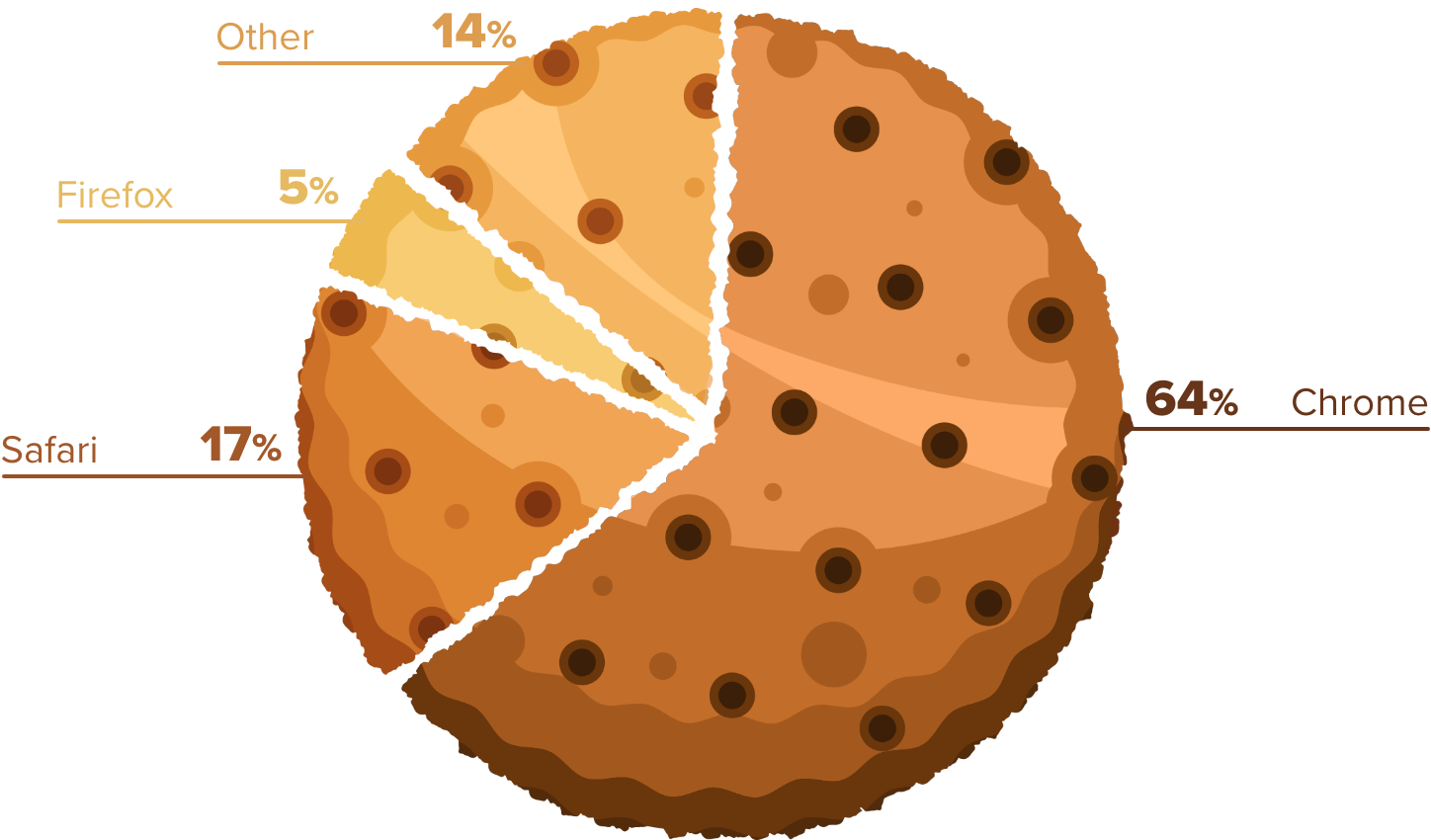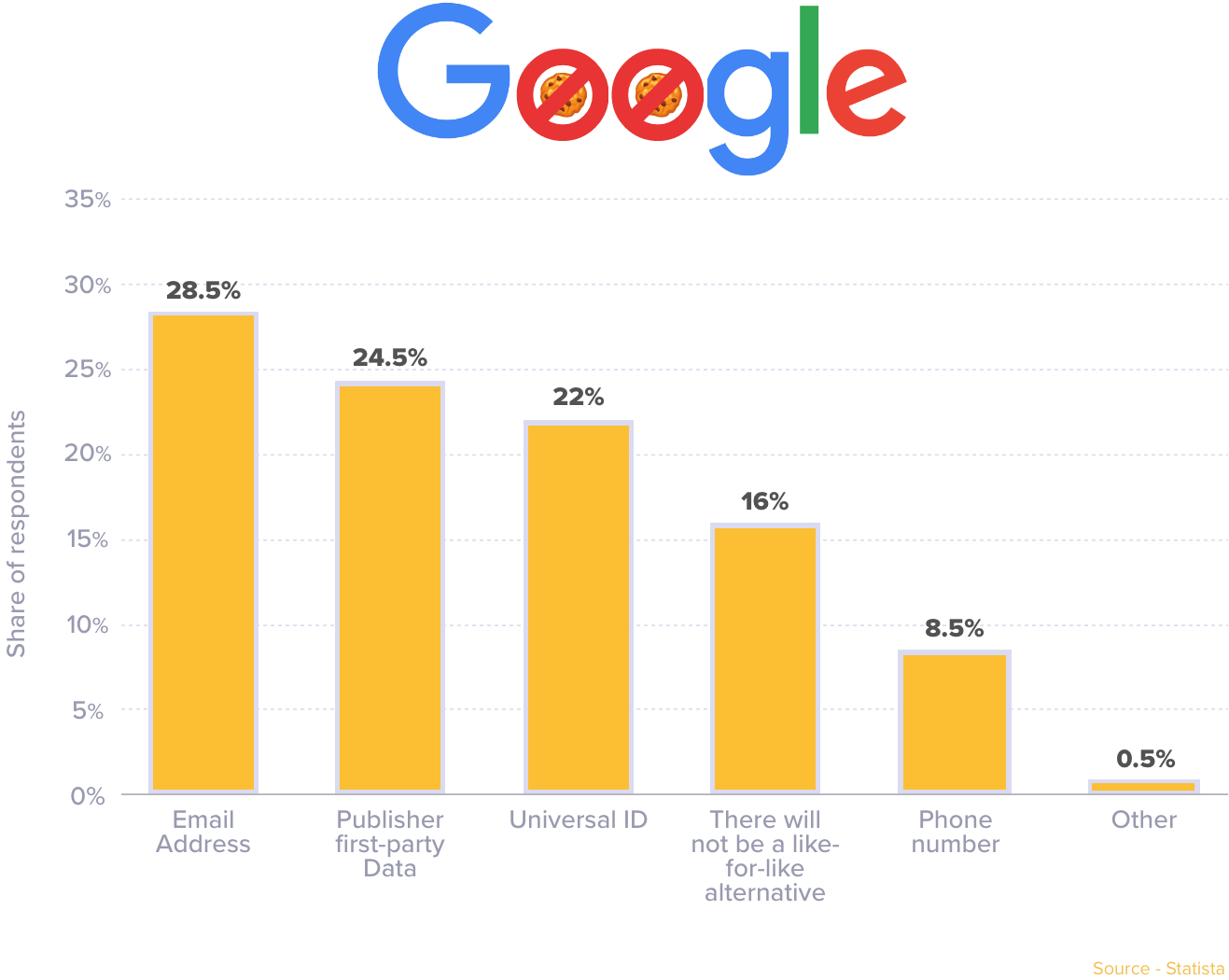In recent years, there has been growing concern over data privacy, and the way that companies collect, store, and use user data. Even Google is set to phase out third-party cookies in Chrome by 2024; that would be a boost in the slow demise of third-party cookies.
As a result, there has been a push towards a "cookieless future", which would involve a shift away from the use of cookies to track user behavior online.
In a cookieless future, websites would no longer rely on cookies to track user behavior. Instead, they would use other methods to collect data, such as zero-party and first-party data.
83% of marketers are reliant on third-party cookies.
In order to make a marketing campaign a success, data is crucial. It can help marketers identify trends, understand the audience better with detailed breakdowns of their behavior, and preferences and create personalized experiences. Data allows them to make informed decisions and create effective marketing strategies.
In today's digital age, marketers have access to vast amounts of data about their target audience, including their demographics, interests, behavior, and preferences. But with the slow demise of cookie permissions and usage, marketers need to understand this concern and take measured alternate steps.
What is a cookieless future?
‘Cookieless future’ refers to the ongoing trend of decreasing reliance on third-party cookies for data tracking and collection in digital advertising and analytics. Cookies are small text files stored on a user's device by websites to track their behavior and preferences. However, as concerns over privacy and data protection increase, many web browsers are phasing out support for third-party cookies, making it more difficult for advertisers to track users across different websites.
This shift towards a cookieless future means that businesses will need to find new ways to collect and analyze data on their audiences. Some alternatives include using zero-party data, first-party data, or contextual advertising and using new technologies such as machine learning and artificial intelligence to analyze data in a more privacy-friendly way.

The shift towards a cookieless future is not without its challenges. Companies will need to invest in new technologies and strategies to collect and use zero-party and first-party data effectively. Additionally, without cookies, it may be more difficult for advertisers to serve targeted ads, which could impact the revenue of some companies.A Statista report states that “83% of marketers are reliant on third-party cookies.”
Overall, the move towards a cookieless future represents a positive step towards protecting user privacy and giving users more control over their personal information. However, it will require significant changes to the way that companies collect and use data, and will likely lead to new challenges and opportunities in the digital landscape.
Why is Google phasing out third-party cookies?
Google’s revelation of the ‘death of cookies’ for Chrome has created a stir in the advertising industry, as cookies have been a key tool for advertisers to track user behavior and deliver targeted ads. However, Google's decision to phase out third-party cookies is driven by concerns over privacy and user data protection.
Cookies can be used to collect sensitive information about users without their consent, and this can lead to privacy breaches. Google has also faced criticism for allowing third-party cookies on its Chrome browser, despite its claims to protect user privacy. By phasing out third-party cookies, Google hopes to address these concerns and protect user privacy. With this happening,a September 2020 report by Statista states “62% of US marketers have developed a First party strategy already.’
This move may create challenges for the advertising industry, as advertisers will have to rely on other methods to target ads to users, such as contextual advertising or first-party data. This can lead to a loss of revenue for advertisers and publishers who rely on targeted advertising. As the advertising industry looks for alternative solutions, it is important to strike a balance between privacy and effective advertising; and that nonetheless would only be adopting a cookieless approach.
Introducing zero-party data
Zero-party data is a type of data that consumers willingly and actively provide to companies, usually in exchange for a reward or benefit. This could include data such as email addresses, phone numbers, and preferences. Zero-party data is valuable because it is given voluntarily, and users have control over how it is used.
It is different from first-party, second-party, and third-party data, which are typically collected passively or without the consumer's knowledge.
Customers willingly share this kind of data with businesses in exchange for personalized experiences and value. This includes customer preferences, purchase history, demographic information, and more. By leveraging zero-party data, businesses can create more tailored experiences for their customers and build stronger relationships with them.
Zero-party data can be incredibly helpful for personalization because it allows companies to gain insights into their customers' preferences and interests. This information can then be used to create more targeted marketing campaigns and deliver more relevant content to customers. Additionally, zero-party data helps companies build stronger relationships with their customers by allowing them to demonstrate that they value their customers’ input and opinions.
The ideal strategy to obtain zero-party data is to request it in exchange for a customer-valued good or service. This might be done using a poll, personalized product recommendations, or a cost-free tool like an eBook.
How is Zero party data obtained?
Zero-party data is completely consumer-provided data that is voluntarily shared by a customer. Customers actively choose to provide and share this data, and the privacy concerns from the business end are not there.
Zero-party data can be obtained through various means, including surveys, polls, social media posts, direct customer feedback forms, loyalty programs, and more.
By using these methods to obtain Zero party data from customers, marketers are able to build a better understanding of their target audience and deliver truly personalized experiences for them.
Companies can also use AI-driven tools such as natural language processing (NLP) to analyze customer conversations and extract valuable insights from them. Additionally, companies can leverage the power of predictive analytics to anticipate customer needs based on past behaviors.
What is first-party data?
The data that is collected directly from a company’s customers or website visitors is called the First party. This data can be used to gain insights into customer behavior and preferences, which can help companies make better decisions about marketing and product development. It can also be used for personalization, segmentation, and targeting. First-party data is considered to be the most reliable form of data as it comes directly from the source. Companies should take advantage of this valuable resource in order to stay ahead of their competition and make informed decisions about their business strategy. A statista report says, ‘41% of marketers increased spending on first-party data in 2022’.

First-party data is essential for personalization as it allows marketers to understand their customers and behavior deeper. It provides insights into what customers are looking for in terms of product offerings, pricing, delivery methods, and more. With this information, marketers can tailor their products and services to meet the needs of their customers. Additionally, first-party data can be used to create targeted campaigns that are tailored to the individual customer’s needs. This makes it easier for businesses to reach out to potential customers who may be interested in their products or services.
How is First party data obtained?
Companies collect first-party data directly from their customers or users. It can be collected through various methods such as surveys, website visits, customer feedback, and more. This data can then be used to gain insights into customer behaviors and preferences which can help businesses make better decisions.
First-party data is a valuable asset for any business as it offers an unprecedented level of insight into customer behavior and preferences. By collecting this data, businesses are able to make more informed decisions about their marketing strategies and product offerings. Additionally, first-party data can also be used to personalize content for customers and improve the overall user experience.
Zero-party vs First-party data:
| Zero-party data | First-party data |
|
Data is shared by the customer itself proactively. |
Data is collected directly from the customer by the company. |
|
Helps in understanding customer behavior better. |
Helps in understanding customer preferences better. |
|
Data is highly relevant and accurate, but comparatively less than first-party data. |
Is more accurate than second and third-party data, and more data than Zero party. |
|
Data is colled through quizzes and polls, website activity, and customer messages. |
Data is colled through website visits and customer feedback. |
|
No privacy concerns. |
Very minimal privacy concerns. |
|
Examples: Customer intentions, social stories, personal context, user profile data, etc. |
Examples: Demographic location, name, email id, behavior, purchase history, feedback, etc. |
What are some other kinds of data?
- Second-party data - Second-party data is data that is collected from an external source, such as a partner or vendor, and shared with another organization. This data can be used to gain insights into customer behavior, preferences, and buying patterns. It can also be used to create more targeted and personalized marketing campaigns. Second-party data is becoming increasingly popular due to its ability to provide valuable insights that can be leveraged for better decision-making. It can help companies improve their customer relationships, increase sales and profits, and gain a competitive edge in the market.
- Third-party data - Third-party data is data collected from external sources, such as public records, surveys, and other sources. It can be used by organizations to gain insights into their customers and markets, as well as to make better decisions about their products and services. Third-party data can also be used for market research purposes, providing companies with valuable insights about their target audiences. Third-party data is often used in combination with first-party data (collected directly from the company's customers) to gain a more complete understanding of customer behavior.
Conclusion
The basic and main difference between collecting zero-party data and first-party data is that zero-party data involves directly engaging your audience. First-party data, on the other hand, offers you insights from analytics and user activity.
Zero-party data collection offers marketers a genuine chance to execute more successful campaigns by gathering information directly from the source—all while fostering trust and transparency with their customer base. While first-party data gives you an understanding of your audience, it doesn't always increase customer trust in brands.
The confusion to choose between the two of these might come as no surprise to a marketer, but it would be a safe and wise choice to speak of that one needs to focus on both of these, depending upon where the customer lies in the marketing funnel of their business.
Don't let cookies crumble your business. Discover how zero-party and first-party data can help you build stronger relationships with your customers and drive more revenue.
Grow your business with a cookieless approach with OpenSense Labs. Contact us today at [email protected] to discuss how we can help your business.
Subscribe
Related Blogs
Exploring Drupal's Single Directory Components: A Game-Changer for Developers

Web development thrives on efficiency and organisation, and Drupal, our favourite CMS, is here to amp that up with its latest…
7 Quick Steps to Create API Documentation Using Postman

If you work with API, you are likely already familiar with Postman, the beloved REST Client trusted by countless developers…
What is Product Engineering Life Cycle?

Imagine constructing a house without a blueprint or a set of plans. It will be challenging to estimate the cost and labor…



